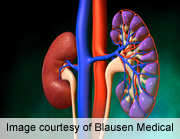
TUESDAY, March 20 (HealthDay News) — A novel technique that uses a kidney transplant recipient’s own stem cells may someday replace or reduce the initial use of anti-rejection medications, new research suggests.
Six months after receiving a kidney transplant, only about 8 percent of people given their own mesenchymal stem cells experienced rejection compared with almost 22 percent of people on the standard anti-rejection drugs, according to the study.
“Mesenchymal stem cells are stem cells that can be differentiated into a variety of cells,” explained Dr. Camillo Ricordi, study senior author and director of the Cell Transplant Center and Diabetes Research Institute at the University of Miami Miller School of Medicine.
“If you infuse mesenchymal stem cells at the time of the transplant, you could replace the use of powerful anti-rejection drugs, and maybe replace immunosuppressants altogether,” he said. This technique could be used in the transplantation of islet cells (in the pancreas) for people with type 1 diabetes, and for other organ transplants, such as the liver, he added.
The people given their own stem cells also had improved kidney function earlier after transplant, Ricordi said.
Results of the study appear in the March 21 issue of the Journal of the American Medical Association.
One of the biggest remaining hurdles in organ transplantation remains the need for powerful anti-rejection and immune-suppressing medications after the transplant.
“Basically, the way we prevent kidney rejections is by putting you on very powerful anti-rejection drugs and immunosuppressive agents to prevent your cells from attacking the foreign organ,” said Dr. Robert Provenzano, chair of the department of nephrology, hypertension and transplantation at St. John Providence Health System in Detroit. “But, the current standard has some problems, like an increased risk of infections and the possibility of creating a cancer.”
The body’s immune system sends out surveillance cells to protect the body against foreign invaders, such as a bacteria, virus or, in this case, a new organ, Provenzano said. The current method of preventing these cells from attacking the new organ is essentially to destroy the surveillance cells. But mesenchymal cells can naturally suppress those surveillance cells so they don’t attack, he said.
To see if this suppression would be enough to prevent rejection, Ricordi and his colleagues, including researchers from Xiamen University in China, recruited 159 people with serious kidney disease who were on dialysis. They ranged in age from 18 to 61.
The study participants all had medically well-matched relatives willing to donate a kidney for transplant.
Each was randomly assigned to receive one of three treatments after transplant. One group got standard treatment with anti-rejection medication (induction therapy) and immune-suppressing medication known as calcineurin inhibitors (CNIs). Another group was infused with their own stem cells and the standard dose of CNIs, while the final group received stem cells plus a lower dose of CNIs (80 percent of the standard dose).
Survival rates for the patients and their new kidney were similar for all three groups at 13 to 30 months, the study found.
But before that, at six months, nearly 21.6 percent of those on standard therapy experienced rejection, compared with 7.5 percent of the stem cell plus standard CNIs, and 7.7 percent in the stem cell plus low-dose CNIs.
Both groups who received stem cells recovered kidney function faster than those on standard therapy. And at one year, the researchers found that the risk of opportunistic infections was reduced by nearly 60 percent in those who got the stem cell treatment.
Provenzano expressed enthusiasm for the new procedure. “I see this as the continued evolution of transplant medicine. It’s very exciting to be able to use your own natural cells instead of more toxic medications,” he said. He added that more studies are needed to confirm these findings and study long-term effects, but said “the data here appears promising.”
Some experts are less impressed. “This is a novel technique, but I don’t think it would be regarded as a significant step forward. It was only significant at six months,” said Dr. Glyn Morgan, the associate director of transplantation at NYU Langone Medical Center in New York City. And, he added, “It’s only a change in the induction protocol. Primary immunosuppressant agents are still used long term.”
Other researchers have also been testing the use of stem cells in transplants. The March 7 issue of Science Translational Medicine reported on an attempt to transfer stem cells from the donor to the transplant recipient before transplant, in an attempt to create a hybrid immune system that would accept the new organ. Five of eight patients studied haven’t needed medications to suppress their immune systems, according to the study.
Ricordi said perhaps a combination of stem cell therapies might lead to even more effective immune suppression.
More information
Learn more about the immune-suppressing medications used after a kidney transplant from the National Kidney Foundation.
